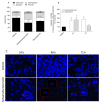Cytotoxic Mechanism of Sphaerodactylomelol, an Uncommon Bromoditerpene Isolated from Sphaerococcus coronopifolius
- PMID: 33806445
- PMCID: PMC7961984
- DOI: 10.3390/molecules26051374
Cytotoxic Mechanism of Sphaerodactylomelol, an Uncommon Bromoditerpene Isolated from Sphaerococcus coronopifolius
Abstract
Marine natural products have exhibited uncommon chemical structures with relevant antitumor properties highlighting their potential to inspire the development of new anticancer agents. The goal of this work was to study the antitumor activities of the brominated diterpene sphaerodactylomelol, a rare example of the dactylomelane family. Cytotoxicity (10-100 µM; 24 h) was evaluated on tumor cells (A549, CACO-2, HCT-15, MCF-7, NCI-H226, PC-3, SH-SY5Y, SK-ML-28) and the effects estimated by MTT assay. Hydrogen peroxide (H2O2) levels and apoptosis biomarkers (membrane translocation of phosphatidylserine, depolarization of mitochondrial membrane potential, Caspase-9 activity, and DNA condensation and/or fragmentation) were studied in the breast adenocarcinoma cellular model (MCF-7) and its genotoxicity on mouse fibroblasts (L929). Sphaerodactylomelol displayed an IC50 range between 33.04 and 89.41 µM without selective activity for a specific tumor tissue. The cells' viability decrease was accompanied by an increase on H2O2 production, a depolarization of mitochondrial membrane potential and an increase of Caspase-9 activity and DNA fragmentation. However, the DNA damage studies in L929 non-malignant cell line suggested that this compound is not genotoxic for normal fibroblasts. Overall, the results suggest that the cytotoxicity of sphaerodactylomelol seems to be mediated by an increase of H2O2 levels and downstream apoptosis.
Keywords: DNA damage; MCF-7 cells; apoptosis; biological activities; breast cancer; marine natural products; oxidative stress; red algae.
Conflict of interest statement
The authors declare no conflict of interest.
Figures





Similar articles
-
Bromoditerpenes from the Red Seaweed Sphaerococcus coronopifolius as Potential Cytotoxic Agents and Proteasome Inhibitors and Related Mechanisms of Action.Mar Drugs. 2022 Oct 20;20(10):652. doi: 10.3390/md20100652. Mar Drugs. 2022. PMID: 36286475 Free PMC article.
-
Disclosing the antitumour potential of the marine bromoditerpene sphaerococcenol A on distinct cancer cellular models.Biomed Pharmacother. 2022 May;149:112886. doi: 10.1016/j.biopha.2022.112886. Epub 2022 Apr 1. Biomed Pharmacother. 2022. PMID: 35378501
-
Antitumor and antimicrobial potential of bromoditerpenes isolated from the red alga, Sphaerococcus coronopifolius.Mar Drugs. 2015 Jan 26;13(2):713-26. doi: 10.3390/md13020713. Mar Drugs. 2015. PMID: 25629386 Free PMC article.
-
Sphaerococcenol A Derivatives: Design, Synthesis, and Cytotoxicity.Mar Drugs. 2024 Sep 5;22(9):408. doi: 10.3390/md22090408. Mar Drugs. 2024. PMID: 39330289 Free PMC article.
-
Halogenated Diterpenes with In Vitro Antitumor Activity from the Red Alga Sphaerococcus coronopifolius.Mar Drugs. 2019 Dec 29;18(1):29. doi: 10.3390/md18010029. Mar Drugs. 2019. PMID: 31905719 Free PMC article.
Cited by
-
Bromoditerpenes from the Red Seaweed Sphaerococcus coronopifolius as Potential Cytotoxic Agents and Proteasome Inhibitors and Related Mechanisms of Action.Mar Drugs. 2022 Oct 20;20(10):652. doi: 10.3390/md20100652. Mar Drugs. 2022. PMID: 36286475 Free PMC article.
-
Marine Compounds, Mitochondria, and Malignancy: A Therapeutic Nexus.Mar Drugs. 2022 Sep 30;20(10):625. doi: 10.3390/md20100625. Mar Drugs. 2022. PMID: 36286449 Free PMC article. Review.
References
-
- Habtetsion T., Ding Z.-C., Pi W., Li T., Lu C., Chen T., Xi C., Spartz H., Liu K., Hao Z., et al. Alteration of Tumor Metabolism by CD4+ T Cells Leads to TNF-α-Dependent Intensification of Oxidative Stress and Tumor Cell Death. Cell Metab. 2018;28:228–242.e6. doi: 10.1016/j.cmet.2018.05.012. - DOI - PMC - PubMed
MeSH terms
Substances
Grants and funding
- UID/MAR/04292/2020/Fundação para a Ciência e a Tecnologia
- UID/Multi/04046/2020/Fundação para a Ciência e a Tecnologia
- UIDB/04046/2020/Fundação para a Ciência e a Tecnologia
- SAICTPAC/0019/ 2015-LISBOA- 01-0145-FEDER-016405/Fundação para a Ciência e a Tecnologia
- PTDC/BIA-OUT/29250/2017/Fundação para a Ciência e a Tecnologia
LinkOut - more resources
Full Text Sources
Other Literature Sources
Medical

